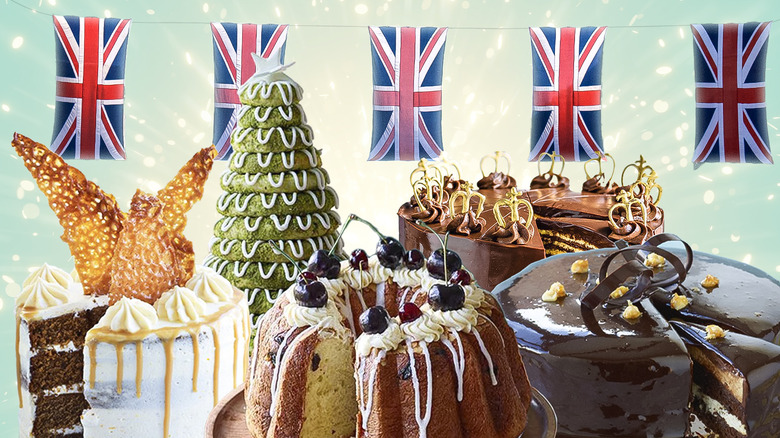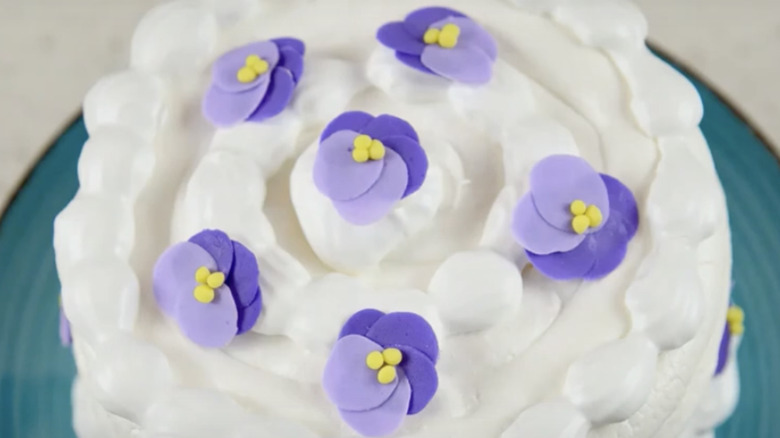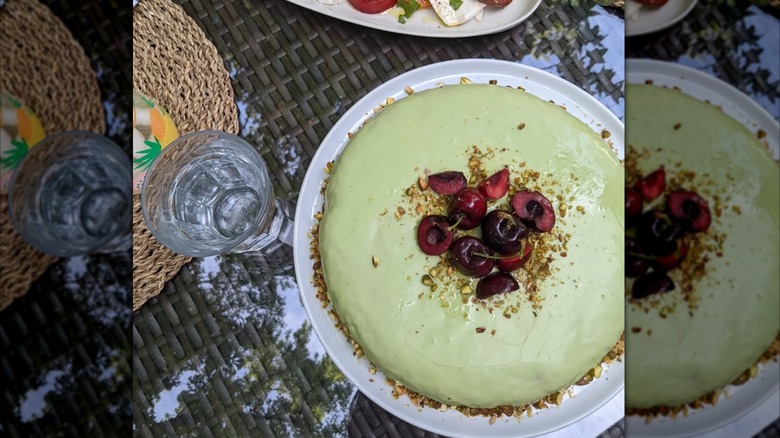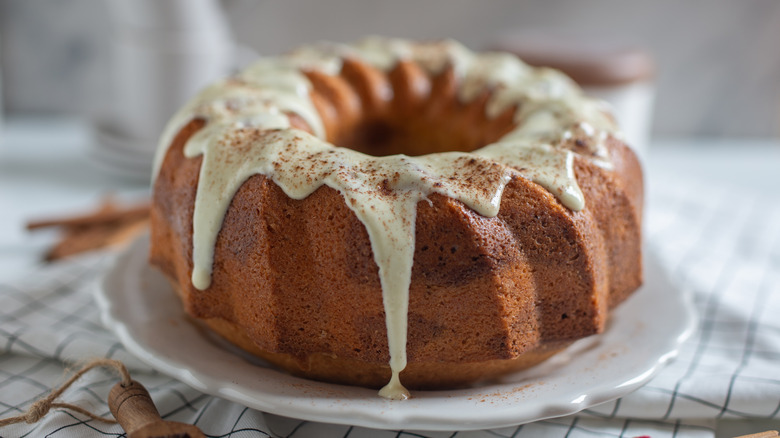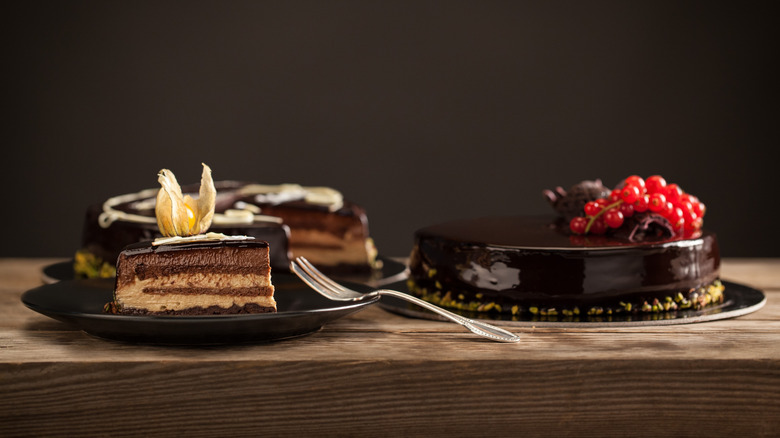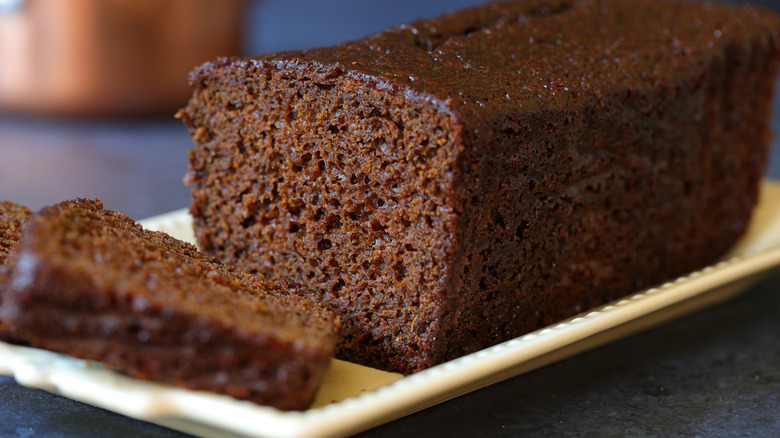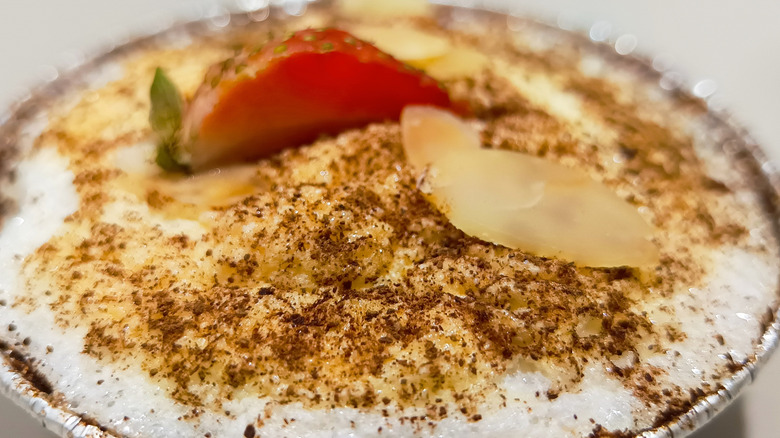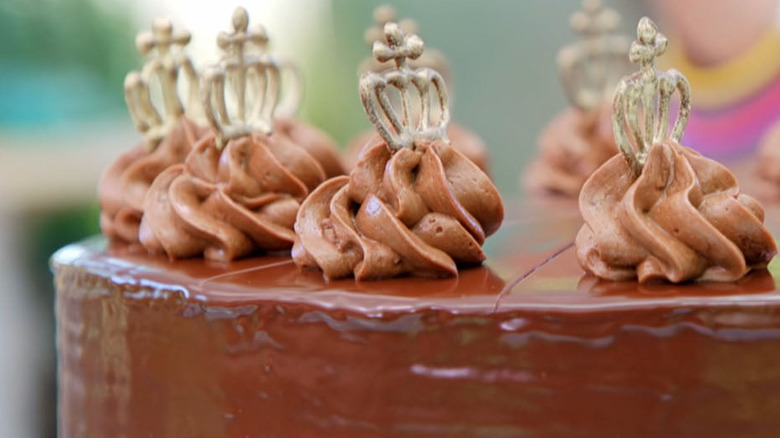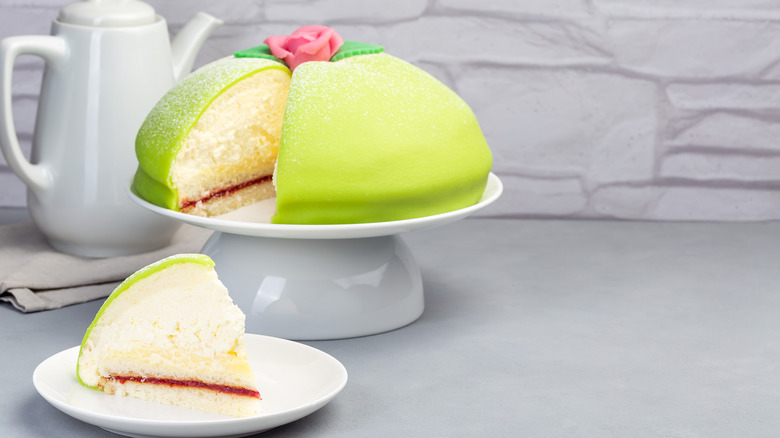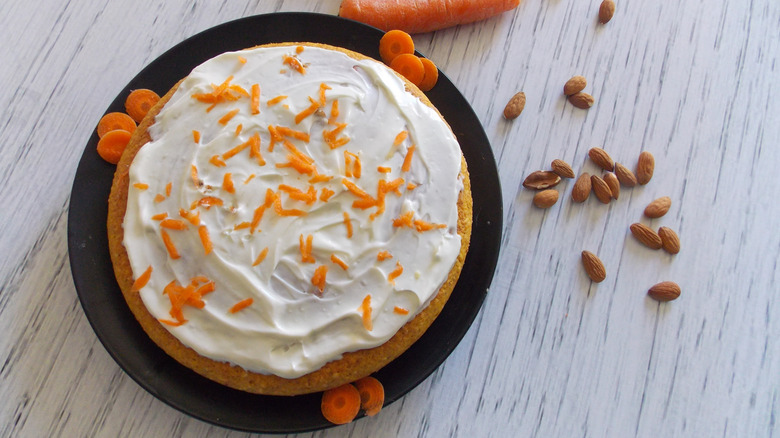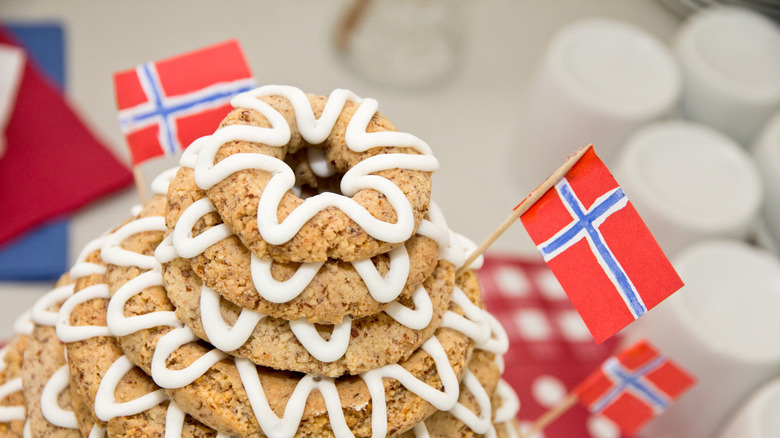10 International Cakes Featured On The Great British Bake Off
"The Great British Bake Off" (GBBO) first appeared on U.K. screens in 2010. Back then, nobody could have guessed how the simple baking competition would capture not just the hearts and minds of its British viewers, but Americans too. In 2015, GBBO ventured across the pond (where it is known as "The Great British Baking Show") and grew into a major hit, with viewers across the U.S. regularly tuning in to see the biggest disasters and most impressive triumphs of the iconic tent. GBBO even has its own spin-off in the U.S., called "The Great American Baking Show," which also features GBBO judges Prue Leith and Paul Hollywood. But the show's appeal doesn't stop in the U.S. In fact, the format for Bake-Off is licensed in 40 countries, including Belgium, Morocco, Argentina, Kenya, and Algeria.
And one way the original GBBO pays tribute to its international reach? Well, it's through cakes, of course. Over the years, many, many different bakes from all over the world have challenged the show's amateur bakers. There have been layered cakes from Austria, spinach cakes from France, milky cakes from Central America, and so many more. Below, we've highlighted some of the best international GBBO cakes to ever grace the tent. Ready, set, bake!
Spanische Windtorte
Vienna, Austria's capital, is full of extravagant buildings and fascinating historical sights. The European city is not a place of understated elegance, as the iconic and sprawling imperial Hofburg Palace can attest. But as well as elegant architecture, Vienna has birthed some incredibly fancy cakes, too. Stacked high with layers of meringue, fruits, and whipped cream, the Spanische Windtorte is one of the most elaborate. It was created during the Austro-Hungarian Empire, and it looks as impressive as it tastes. But it's not easy to make, which was why Mary Berry selected it as the GBBO technical challenge in Series 6, Episode 4, which aired in 2015.
Spanische Windtorte involves simple ingredients, but a heck of a lot of patience. Baking one is an intricate and time-consuming process, involving lots of time waiting for the meringue to cool, as well as delicate piping and intricate edible flower-making skills. The worst part? After all of that, the cake falls apart as soon as you slice into it. But, of course, if baked well, it's bound to taste good.
Ultimately, the bakers struggled with Berry's version of the Spanische Windtorte, which was covered with fondant violets. Even Nadiya Hussain, who went on to win the entire season, came second-to-last in this particularly tricky technical challenge.
Le gâteau vert
Claude Monet is, of course, best known for his paintings, like "Bridge over a Pond of Water Lilies," "Nymphéas," and "Poplars." But the French impressionist's name has also become closely tied to one of his favorite cakes: le gâteau vert — which translates to "the green cake" in English. The color comes from pistachios, alongside another unlikely and green ingredient: spinach.
In 2018, Leith picked le gâteau vert, which Monet often selected as his birthday cake, as her first technical challenge of Series 9 (Episode 2). The cake takes around two hours to make total and involves several steps, including grinding pistachios and wilting spinach before turning it into a puree. After baking, the already thin cake must be sliced horizontally into three layers, which presented a challenge for a few contestants, before being sandwiched together with fondant. And if that wasn't tricky enough, the contestants were then tasked with decorating the cake in the style of one of Monet's paintings.
Le gâteau vert isn't the only gâteau (which means "cake" in French) that has appeared on GBBO. In Series 11, for example, contestant Lottie Bedlow was praised for her Black Forest gâteau. While the "cake" portion of the name is French, the Black Forest gâteau actually originated in the Black Forest region of Germany. Fun fact: Brits also use the term gâteau for their cakes, but in the U.K., it generally only refers to cakes that are light, fruity, and creamy.
Gugelhupf
Another impressive-looking cake from Central Europe is the gugelhupf. This type of marble sponge cake is not quite as grand as Spanische Windtorte, but it's just as beloved and elegant. This Bundt cake is shaped like a ring with a hole in the center. In Series 12, Giuseppe Dell'Anno (who, spoiler alert, would go on to win the season), picked a gugelhupf cake as his showstopper. His bake, topped with rum-infused cherries and filled with vanilla custard, would help him win the coveted Star Baker title for the episode.
The origin of gugelhupf is contested, though it remains popular in Germany, Austria, and countries across Central Europe. The name actually comes from medieval German and was likely inspired by the shape of the cake. "Gugel" means "long, pointed hood," while "hupf" means jump — likely referencing how quickly the cake rises in the oven. The cake's shape is common now; people can buy their own Bundt tins to make any type of cake they fancy, including sticky toffee and chocolate cream cheese.
Gugelhupf's German connection is likely why the cake was featured in Series 12's German Week. Other German bakes from this episode include mandelhörnchen (German almond cookies) and Prinzregententorte.
Torta setteveli
A semi-final calls for a complicated technical challenge, and Prue Leith delivered by choosing a torta setteveli for the contestants to tackle in Series 9. The seven-layered Italian cake was created by three renowned pastry chefs (Luigi Biasetto, Cristian Beduschi, and Gianluca Mannori) in the 1990s, in a bid to win the World Pastry Cup (also known as the Coupe du Monde de la Pâtisserie). Ultimately, their efforts paid off, and the trio took home the crown in 1997.
Torta setteveli cakes are not easy to make, largely due to their sheer number of layers. They consist of two chocolate cake layers, two layers of hazelnut cream, one layer of hazelnut crunch, and one layer of chocolate mousse — all topped with a mirror glaze. At the time, the torta setteveli was the longest technical challenge in the show's history, with bakers given three and a half hours to impress the judges.
According to Leith, even a professional would feel immense pressure if asked to make torta setteveli, given how incredibly complicated it is to make. The Series 9 bakers rose to the challenge though, with Ruby Bhogal winning first place for her standout attempt at the decadent Italian cake.
Jamaican ginger cake
Before she impressed judges Prue Leith and Paul Hollywood with her torta setteveli in the semi-finals (Series 9, Episode 9), Ruby Bhogal created a Jamaican ginger cake in honor of Spice Week. In fact, all the bakers in this episode were tasked with baking some form of ginger cake.
Many countries, including Sweden, have a history of baking with ginger, but the spice has a particularly long history in Jamaica. It has long grown in abundance on the island — at least until recently, when it was plagued by ginger rhizome rot — and appears in many traditional recipes. Jamaican bulla cakes, for example, are made with ginger along with other spices like cinnamon and nutmeg. Ginger cake is also popular in the U.K., due to the colonial ties between the two countries.
Bhogal's GBBO cake was a tribute to Jamaica, named the "Jamaican Me Crazy" ginger cake. She's not the only contestant to have whipped up a bake inspired by the Caribbean island. In Series 11, Loriea Campbell-Clarey also created a chili and chocolate cake with rum-infused buttercream, called "A Slice of Jamaica." In Series 1, Annetha Mills baked a Jamaican black cake with strawberries and cream. Black cake is a popular Caribbean Christmas cake. The original recipe was likely inspired by British plum pudding recipes, but today it contains burnt sugar, fruits, like currants, cherries, prunes, and plenty of spices, like nutmeg and cinnamon.
Tres leches
Tres leches is a beloved celebration cake enjoyed across Central America. Nobody knows for certain which country it originated, but many believe it started out in Mexico or Nicaragua. Its origins may be murky, but one thing is certain: This is not your typical sponge cake. It's usually soaked in condensed milk, evaporated milk, and whole milk (tres leches translates to "three milks") and supposed to be light, fluffy, and moist — but not overly soggy.
Tres leches is a complex bake, which is why it was chosen for the showstopper round in Series 13's Mexican Week episode. But this is GBBO, so the judges had to take it up a notch, adding a new rule that the cake must consist of at least four layers. Unsurprisingly, many of the contestants struggled with the challenge. The late Dawn Hollyoak, however, received a round of applause for her attempt at this complicated twist on the Latin American favorite.
Other Latin American treats whipped up by the bakers in this episode included pan de leche (a type of sweet milk bread) and, unusually for GBBO, steak tacos. Of course, for the latter, the tortillas had to be baked from scratch. It's important to note that, while it may be beloved and iconic, the Bake-Off doesn't always hit the right notes. Its attempt at inclusivity with Mexican Week was controversial and heavily criticized for reinforcing harmful stereotypes and for showcasing a lack of any real knowledge of Mexican cuisine.
Prinzregententorte
Germany's Bavaria region has given us many culinary favorites, like soft pretzels, of course, and German potato dumplings. But a particularly grand cake called Prinzregententorte also hails from this part of the world. The name was inspired by Prince Regent Luitpold, who ruled over the region from 1886 until 1912. At the beginning of his reign, a local baker created the Prinzregententorte cake especially for the royal. Some maintain that the baker's identity is unknown; however, others believe it was Heinz Georg Erbhäuser. It makes sense, as Erbhäuser was a confectioner in Munich during Luitpold's reign.
Regardless of who first made the Prinzregententorte, the fact remains that this cake is extravagant to look at and make. Like a torta setteveli, traditional Prinzregententorte cakes consist of eight layers, each one representing an administrative district of Bavaria. Some recipes now only consist of seven layers, to acknowledge the loss of one of Bavaria's districts after World War I, but the Bake-Off stuck to the eight-layer version. With layers of Genoise sponge, chocolate cream, and ganache, Prinzregententorte cakes are notoriously fussy to make. So, of course, you guessed it, Prinzregententorte had to be the technical challenge in Series 12's German Week episode.
The challenge was made even trickier by the request to decorate each Prinzregententorte with rosettes and chocolate crowns, in honor of the cake's royal history. Giuseppe Dell'Anno went on to win the round thanks to his impressive presentation and even layering.
Swedish Princess Cake
Yep, it's another royal cake. This time, as the name implies, the Swedish Princess Cake was beloved by three princesses, Margaretha, Märtha, and Astrid of Sweden. It was developed for them by home economist Jenny Akerström, who taught the young royals in the 1920s. A century later, the cake is still a popular treat in Sweden. It a marzipan-covered, dome-shaped sponge cake layered with raspberry jam, vanilla custard, and whipped cream.
In 2014, GBBO bakers were asked to make a Swedish Princess Cake for their technical challenge. Making this cake is no mean feat, as it involves no less than 26 ingredients and 14 different steps. Ultimately, Nancy Birtwhistle, who went on to win the entire series, proved her talent for baking and was crowned the champion of the technical round with her take on the Swedish royal favorite.
The princess cake isn't the only time a Scandinavian recipe has been featured on GBBO. In 2018, the show featured Danish Week, which saw the bakers take on everything from smørrebrød (an open-faced sandwich) to Æbleskiver (a Danish pancake puff). This attempt at a themed week was more successful and well-received than Mexican Week, perhaps because it honored one of the hosts, Sandi Toksvig, who is actually of Danish heritage.
Italian carrot cake
Thanks to Italy, the world has many delicious desserts. As if gelato weren't enough, we can also credit the country for delights like panna cotta, amaretti, and Camilla cake. If you've not tried that last one yet, it deserves a place on your bake list. The citrusy carrot cake is simple, fluffy, light, and virtually a guaranteed crowd-pleaser, which is why Giuseppe Dell'Anno chose it for the carrot cake challenge in the finale of Series 12.
Dell'Anno's version also featured fig and walnut jam, cream cheese frosting, candied carrot curls, and candied walnuts. His bake was generally well received, with Prue Leith and Paul Hollywood praising the flavor of the cake and the addition of figs — though they noted the texture was slightly too moist. The cake should be soft and fresh, but never soggy or wet (as with most cakes, to be honest).
Dell'Anno got to show off his Italian heritage more than once throughout Series 12. In Episode 9, the semi-final, he also whipped up another Italian classic: tiramisu. The beloved dessert is elegant, rich, creamy, and made with coffee-soaked ladyfingers, cocoa, and mascarpone. Dell'Anno's version was sliced and included sultanas –which are not a traditional element of the dessert. GBBO has also featured Italian recipes before. In 2017, the show featured its first Italian Week, which followed bakers as they attempted some of the country's most iconic recipes, including cannoli, pizza dough, and sfogliatelle (a multi-layered Neapolitan pastry).
Kransekake
If you've ever attended a Norwegian wedding or Christmas party, you might have seen a towering, layered cake in the corner, decorated with Norwegian flags. It's called a kransekake, and it's traditionally served at celebrations across Norway (and other countries across Scandinavia). A kransekake consists of several almond ring cakes stacked on top of each other and decorated with icing or frosting.
Making a kransekake can be a time-consuming process, but the resulting cake is visually stunning, so of course it was the perfect choice for Paul Hollywood's Christmas Masterclass episode. The holiday special was a little different from other GBBO episodes because it didn't feature any contestants. Instead, the show was led by Hollywood and co-host Mary Berry, who walked viewers through how to make show-stopping cakes for the holiday season. The episode also featured Genoa cake, which is a popular Italian Christmas cake. St. Lucia buns also made an appearance in the festive episode. Despite the name, these sweet, buttery buns don't hail from the Caribbean island — they're actually from Sweden.
Other Christmas specials have featured contestants. In 2024, for example, stars from the U.K.'s beloved soaps (like "Coronation Street" and "EastEnders") worked together to make a Yule log, which again, likely has Nordic origins.
